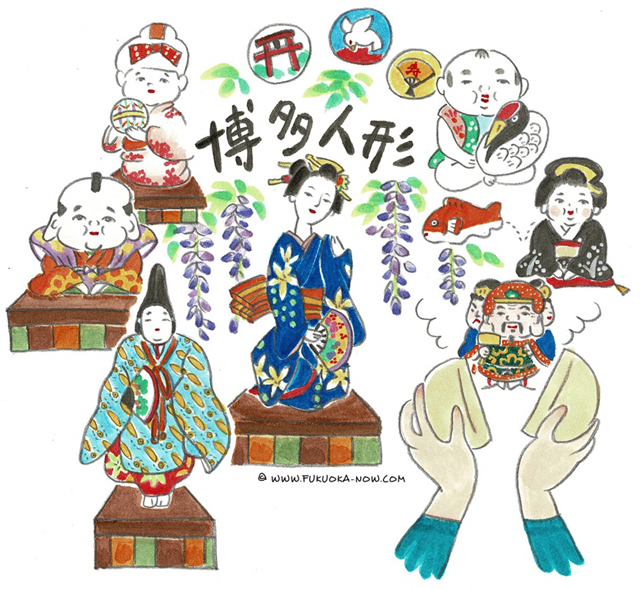Hakata Culture vol.158
Hakata Dolls: Always Changing with the Times

Hakata dolls, one of Fukuoka's traditional handicrafts, are unglazed porcelain figurines characterized by their smooth white skin. The Bijin Mono (“Beautiful Lady”) series of dolls is especially well known. Hakata dolls date back to around 1600 when Nagamasa Kuroda assumed the lordship Chikuzen (now Fukuoka) and numerous artisans moved to Fukuoka from all over Japan coinciding with the construction of Fukuoka Castle. The dolls that these artisans made in their downtime were the original Hakata dolls.
In the late Edo era, when trade with other regions was brisk, Hakata dolls gained a reputation as the preeminent souvenir from Hakata. What’s more, Hakata dolls were put on display at the Paris Expo in the Meiji era, which boosted their popularity abroad. In addition to the Bijin Mono series, other motifs include Noh and kabuki actors, samurai, children, and the Seven Gods of Good Fortune. Many locals are also fond of the zodiac animal dolls that are released every year.
The lifestyles of the Japanese people have changed dramatically since olden times, so fewer households own Hakata dolls nowadays. This is why artisans have been trying new things to keep the tradition alive, like using doll-making techniques to create colorful ohajiki discs with motifs that change every year. These ohajiki used to only be sold at the Hojoya festival at Hakozaki Shrine, but due to their wild popularity, they are now available year-round.
Another initiative that has gained attention is the Hakata doll capsule toys made primarily by young artisans. The hand-crafted miniatures are only available in limited quantities, so they sell out quickly. Yet another endeavor is the Hakata Ofuku project, a collaboration with the Faculty of Art and Design at Kyushu Sangyo University under which young art students create original Hakata dolls with a fresh twist. You can visit the Hakata Traditional Craft Center to see the Hakata dolls display, some of which are for sale.
時代に合わせて進化する博多人形
博多人形は福岡の伝統工芸品のひとつで、すべすべとした白い肌が特徴の素焼きの土人形です。美しい女性をテーマにした「美人もの」と呼ばれる人形が知られています。博多人形の発祥は1600年ごろで、黒田長政が筑前の国(現在の福岡)に入り、福岡城をつくる際に全国からたくさんの職人が集められました。この職人たちが仕事の合間に焼いた人形が現在の博多人形の原型です。
江戸時代後期になると各地との交易が盛んになり、博多人形は博多の土産物として広く知られるようになります。さらに明治時代にはパリなどで開かれた博覧会にも出品され、海外でも高い評価を受けるようになりました。美人もののほかに、能や歌舞伎、侍や子どもの姿、七福神などの神様を題材としたものなど、さまざまな人形があります。毎年の干支の人形でもおなじみです。
一方で日本のライフスタイルは大きく変わり、博多人形が飾られていた床の間などを持つ家が少なくなりました。そこで博多人形もさまざまな工夫をしています。そのひとつが人形制作の技法を生かして作られた色とりどりの「おはじき」。毎年題材が変わり、以前は筥崎宮の秋祭り・放生会だけで売っていましたが、あまりの人気に現在では通年販売になっています。
また、若手人形師が中心になって試みた博多人形のガチャガチャも評判になりました。博多人形はすべて手作りで、販売個数が限られていることから、こちらもすぐに売り切れてしまう人気ぶり。芸術学部のある九州産業大学とコラボレーションした「ハカタオフク」という活動もあります。学生たちの感性が新しい博多人形を生み出しています。博多人形は、はかた伝統工芸館などで見られるほか、販売もしています。

